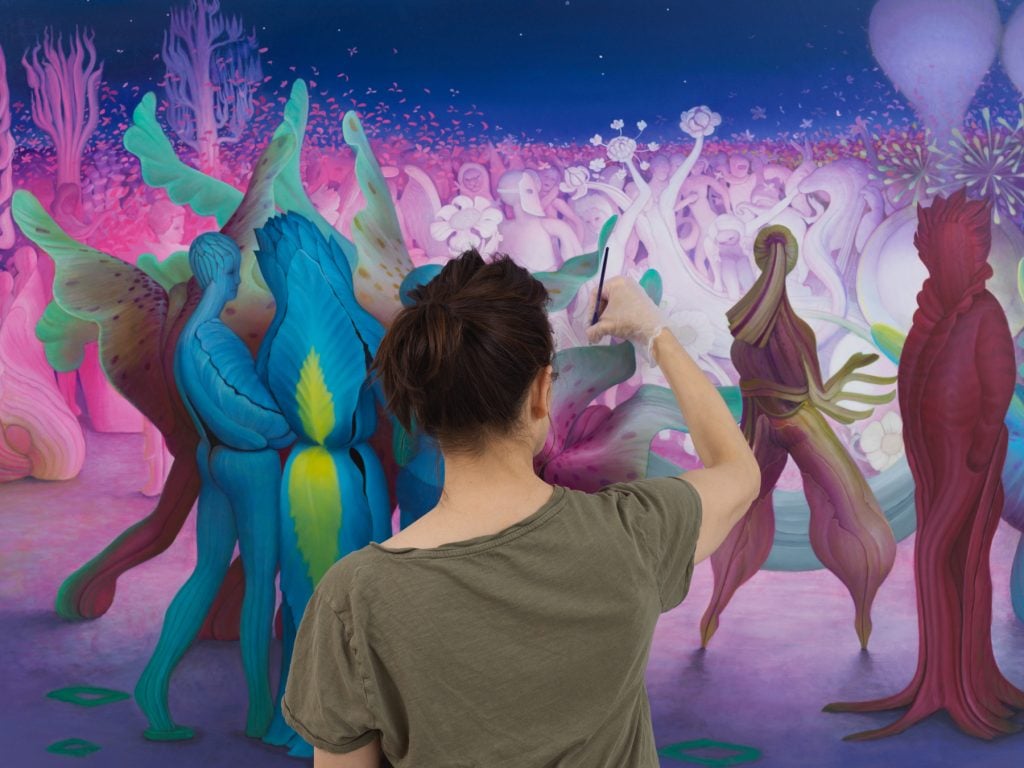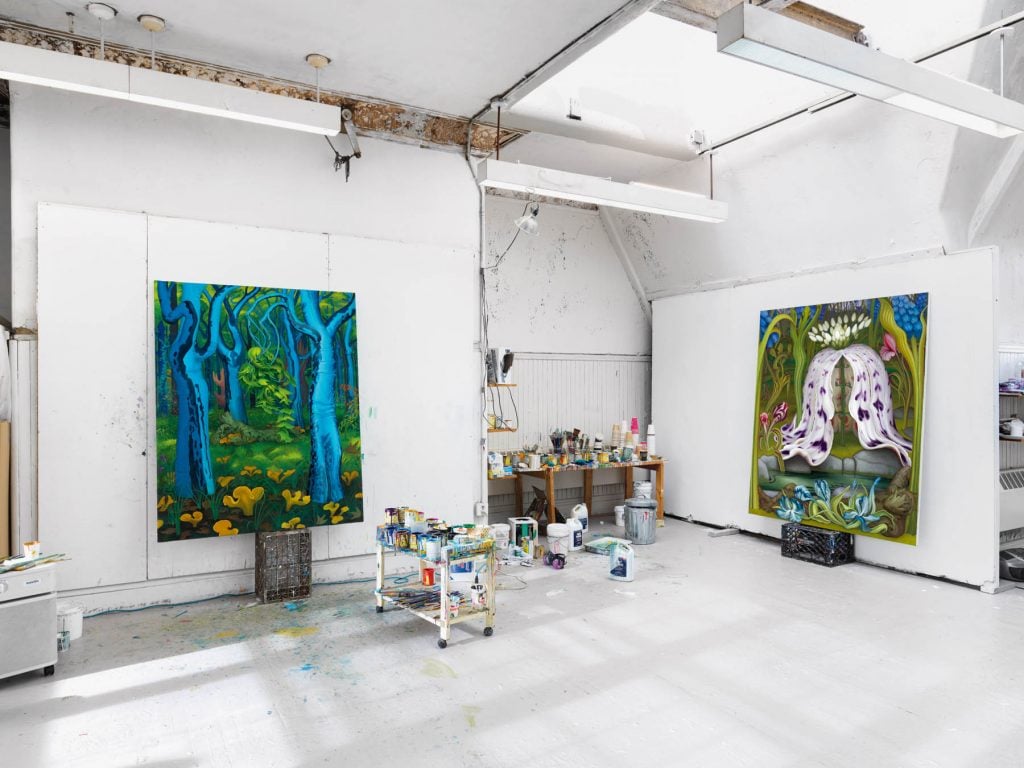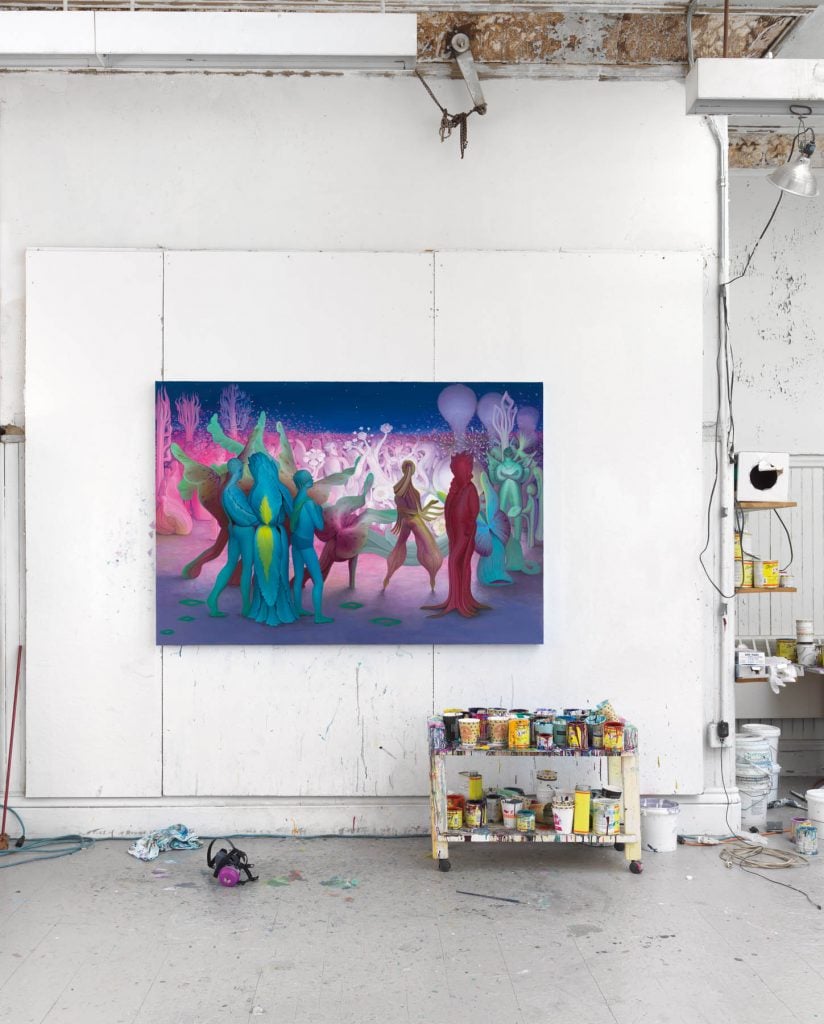Inka Essenhigh thinks painting is a private matter.
The American artist has two studios, one nestled in the woods of Maine, the other on the fifth floor of an old building in downtown Manhattan. While the worlds outside the studio doors can be very different, life inside is remarkably similar. Essenhigh spends her days in the studio drinking coffee and passionately working and reworking her fantastical nature-inspired canvases until her paintings resonate with her intuition. She doesn’t let anyone see her work – until it’s finished, that is – and her only visitor is often her husband, painter Steve Mumford, who delivers lunch or yet another cup of coffee.
Such intimacy is essential; Essenhigh’s ethereal, fantastical landscapes are painted entirely from his imagination, with no preparatory drawings or sketches, and Essenhigh must avoid outside influence. But when his works are finished, they are luminous. At the moment an exhibition of his recently created paintings is on view at the Miles McEnery Gallery in New York (until June 3). These lush, magical paintings evoke a kaleidoscopic world of cascading evergreen forests, flower-like nymphs and fairies, and sultry, drooping flowers that seem to spill from the canvas and into our eyes. The works radiate color – an effect of the enamel paints she uses, providing delicious brilliant bursts of color.
Recently, we caught up with the artist who told us about what her two studios have in common, what brand of paint she (and Jackson Pollock) swear by, and why it might take her a minute to answer the phone. .

In Inka Essenhigh’s studio. Photo: Dan Bradica. Courtesy of Inka Essenhigh.
Tell us about your workshop. Where is it, how did you find it, what type of space is it, etc. ?
I have two studios. One is in lower Manhattan where I’ve been since the early 90s, and the other is a space I had built in St. George, Maine around 2008. The space I built in Maine is very similar to the space that I have in New York. Both are square, white spaces with a large jagged skylight. In town, I have the southern light; in Maine, I have a north facing light. In town, I’m on the fifth floor. In Maine, I’m in a forest by the St. George River.
What made you choose this studio over others?
I don’t think you choose a studio in New York. Most of the time, you’re happy with what you find, but in my case, I like what I found (or what found me).
Do you have studio assistants or other team members working with you? What are they doing?
I have my stretchers made and delivered and that’s all I have for help with my actual paintings. I paint alone. I invent them as I go. I could never give them to someone else to fill in, there are no sketches to follow, no road maps at all. I have a “destination” for what I want the painting experience to be, but I find out what the experience will be like as I paint. So there’s really no way anyone can help. I had help organizing my archives, my website and keeping track of my images. I actually don’t like hiring people and when I’ve done it in the past, I always felt like I was working for them, finding something to do. I rely on my galleries to keep better records than I do.
How many hours do you typically spend in the studio, what time of day do you feel most productive, and what activities take up the majority of that time?
I am a morning person. I arrive at the studio after dropping my child off at school, around 8:30 a.m., coffee in hand. I sit down and look at the painting I’m working on and sip my coffee and come up with what I hope to accomplish that day and immediately get to work. My husband works in a studio adjacent to mine. He usually comes a few hours later and brings me a cup of coffee and sometimes lunch. Most of my time is spent painting. I wear vinyl gloves and even an oven mitt on my left hand – the hand that holds a wiping rag with mineral spirits, as well as a respirator. I take short breaks when the respirator gets too boring, heavy and clammy on my face. I hate that the respirator leaves creases on my face. If the phone rings, it’s a production to take everything off so it’s a real interruption. I hang out around 3 p.m. and I get home at 5:30 p.m.

In the New York studio of Inka Essenhigh. Photo: Dan Bradica. Courtesy of Inka Essenhigh.
What is the studio task on your calendar this week that you are most looking forward to?
All I do is paint and I do one painting at a time and that’s what I’m looking forward to. I like everything, the beginning, the middle and the end. I like to be left alone for long periods of time. I like to work on a group of paintings that are going to be seen next to each other and see how they talk to each other.
What are you working on at the moment? Please send us some smartphone photos of a work in progress.
I don’t do this anymore because of the seeking nature of my process. I no longer expose myself to people saying they liked it so much better when it was in that phase, or why did I turn that yellow field into a blue field? Things can look great with nice paint and color, but if that’s not the experience I want, then I change it
It can be mystifying to people. People might ask: why not just be happy with this and create a new one? It looks like art! People love to look at a big smudge of paint and say, “Oh, that’s so exciting! Why not leave that?!”
If there’s anything that’s improved in my work, it’s because I’ve finally put all that talk of letting the paint dictate what happens. For my work it’s not the painting, it’s the energy that animates the painting. I think in New York with its Ab-Ex heritage, it tipped the scales into thinking that the painting itself is in charge, which it is for some artists but not for me.
I don’t think the world needs another decent looking painting that lacks purpose, love and completion.
What tool or art supply do you most enjoy working with, and why?
I paint with sign painter’s enamel, a brand called One Shot. There are a few artists who use it like Marilyn Minter, Gary Hume, and most notably, Jackson Pollock, whose drip paintings were done with enamel paint. The oil does not flow like that. The enamel is runny and I like to create crisp, clean shapes and lines that are sanded and layered.
How do you know when a work you are working on clicks? How do you know that a work you are working on is a failure?
A work of art clicks as my own eye muscles begin to relax and drink into the image. If I’m staring hard, squinting and such, that means I’m making it work in my mind, but it hasn’t resolved to a real place yet.

In Inka Essenhigh’s studio. Photo: Dan Bradica. Courtesy of Inka Essenhigh.
When you feel stuck while preparing for a show, what do you do to get out of it?
I’m not really stuck because changing the paint is part of the process. At worst, I can be bored but that means I have to go further, I have to redo the image or the form with more love and attention.
What is the most chic object in your studio? The humblest?
There is nothing extraordinary in my studio. I have no computer or equipment of any kind. No fancy furniture, no special fancy lighting setup. I have an old trashed antique couch and table my husband bought when he was younger; the bathroom and sink are at the end of the hall. I listen to music on my iPhone. But in some ways, my studio is the most luxurious studio I’ve ever seen because it has a huge jagged skylight and windows on both sides. A cross breeze in Manhattan is a rare and wonderful thing.
Describe the space in three adjectives.
Light, airy, old and crumbly. It’s four.
What’s the last thing you do before leaving the studio at the end of the day (other than turning off the lights)?
I say to my paintings: “Okay, everyone, nice work! Good job today! We’ll find the rest tomorrow, good evening!
What do you like to do right after that?
I go home to cook dinner for my family.
Follow Artnet News on Facebook:
Want to stay one step ahead of the art world? Subscribe to our newsletter to receive breaking news, revealing interviews and incisive reviews that move the conversation forward.
